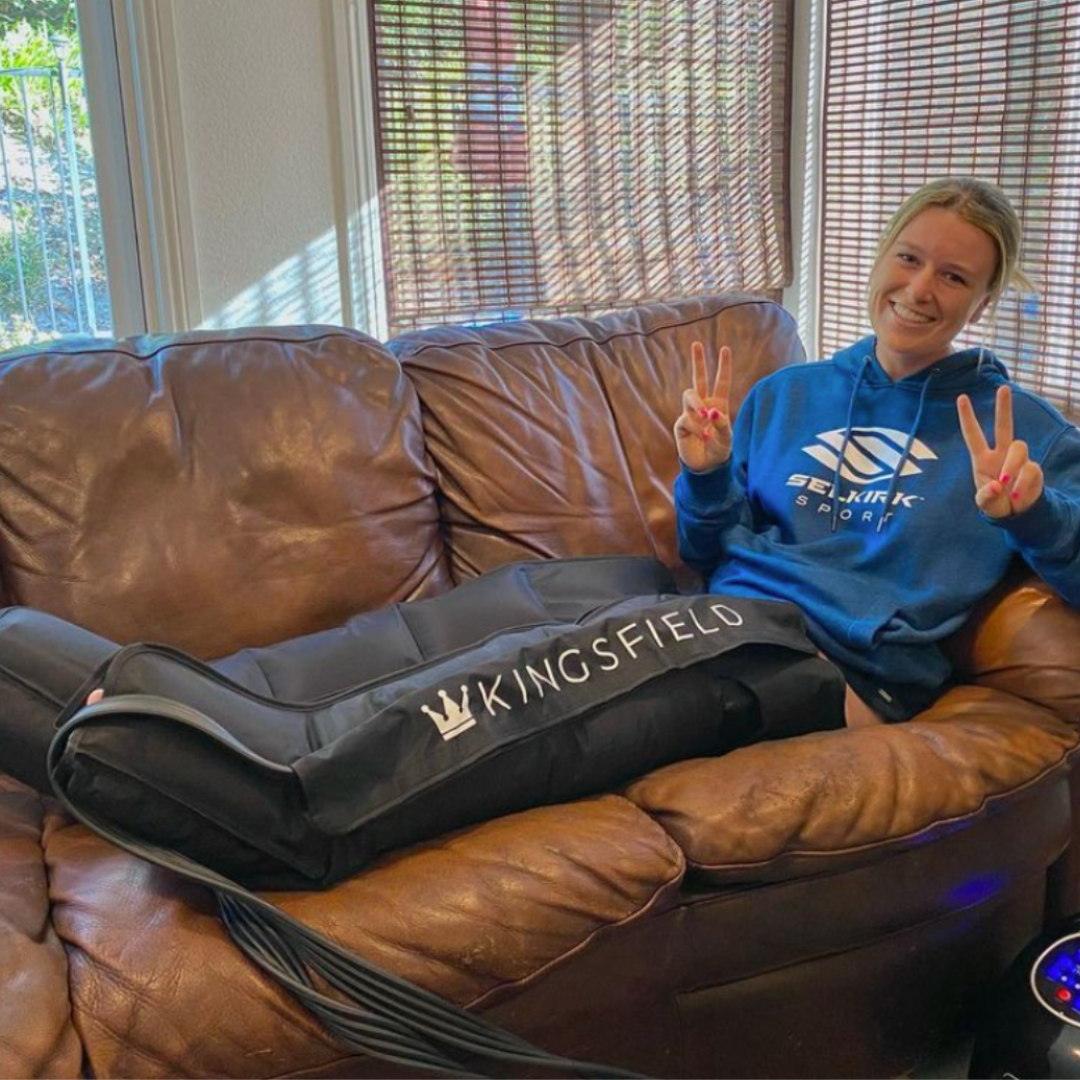The Benefits of Using Compression Boots for Athletes
As an athlete, recovery is just as important as training. The faster you can recover from a workout or competition, the more time you can spend training and improving your performance. One of the latest recovery tools gaining popularity among athletes is compression boots. Compression boots are a type of recovery device that provide a range of benefits, including increased circulation, reduced muscle soreness, and faster recovery times.
How Compression Boots Work
Compression boots work by applying pressure to your legs, starting at your feet and working their way up to your hips. The pressure is delivered through inflatable chambers that fill with air, creating a squeezing sensation that helps to increase blood flow and lymphatic drainage. The pressure is then released, allowing fresh blood to flow back into the area.
Compression boots use a process called pneumatic compression to apply pressure to the legs. Pneumatic compression involves inflating and deflating the chambers in the boots to create a rhythmic squeezing motion. This motion helps to move blood and lymphatic fluid up and out of the legs, reducing inflammation and promoting faster recovery.
The pressure in the boots is usually delivered in cycles, with the boots inflating and deflating at specific intervals. This helps to create a pumping action that improves circulation and encourages the removal of waste products from the muscles.
Compression boots also come with various settings that allow athletes to adjust the pressure and cycle times to their individual needs. This customization allows athletes to target specific areas of their legs or adjust the pressure based on the intensity of their workout.
In addition to helping with circulation and lymphatic drainage, compression boots can also help to reduce the build-up of lactic acid in the muscles. Lactic acid is a byproduct of exercise that can cause fatigue and soreness. By increasing blood flow and lymphatic drainage, compression boots help to remove lactic acid from the muscles more quickly, reducing the risk of soreness and helping athletes to recover faster.
Overall, compression boots are an effective tool for improving circulation, promoting recovery, and reducing muscle soreness. By using pneumatic compression to create a rhythmic squeezing motion, compression boots can help athletes to perform at their best and recover more quickly from intense workouts or competitions.
Increased Circulation
One of the main benefits of using compression boots is increased circulation. When you exercise, your muscles need oxygen and nutrients to perform. Blood carries these essential components to your muscles, and the faster your blood can circulate, the faster your muscles can recover. Compression boots help to increase circulation by applying pressure to your legs, which helps to push blood and lymphatic fluid back up towards your heart. This increased circulation helps to reduce inflammation and muscle soreness, allowing you to recover faster and perform better.
Compression boots work by applying pressure to your legs in a specific pattern. This pressure helps to improve blood flow by promoting the contraction of the veins in your legs. As the veins contract, they push blood back towards your heart, which helps to improve circulation and oxygen delivery to your muscles.
In addition to promoting the contraction of the veins, compression boots also help to stimulate the lymphatic system. The lymphatic system is responsible for removing waste products from your body, and it works in close collaboration with the circulatory system. By improving lymphatic drainage, compression boots help to reduce inflammation and swelling, which can impede circulation and slow down recovery.
Compression boots can also help to prevent blood pooling in the legs, which can be a problem for athletes who spend long periods of time sitting or standing. When blood pools in the legs, it can cause discomfort and lead to circulatory problems over time. By applying pressure to the legs, compression boots help to keep blood flowing and prevent blood from pooling in the legs.
Overall, compression boots are a powerful tool for improving circulation and promoting recovery in athletes. By improving blood flow, lymphatic drainage, and preventing blood pooling, compression boots can help athletes recover more quickly and perform at their best.

Reduced Muscle Soreness
Another benefit of using compression boots is reduced muscle soreness. After a tough workout or competition, your muscles can become sore and stiff. This soreness is caused by tiny tears in your muscle fibers that occur during exercise. Compression boots help to reduce muscle soreness by increasing circulation and lymphatic drainage, which helps to remove waste products and reduce inflammation. This allows your muscles to recover faster, reducing the amount of time you spend feeling sore and achy.
In addition to increasing circulation and lymphatic drainage, compression boots also help to flush out lactic acid from your muscles. Lactic acid is a byproduct of exercise that can build up in your muscles and contribute to soreness and fatigue. By helping to remove lactic acid and other waste products, compression boots can help you recover more quickly and feel less fatigued after a tough workout.
In fact, research has shown that using compression boots can significantly reduce muscle soreness and improve muscle recovery time. In one study, athletes who used compression boots after a workout reported less muscle soreness and were able to perform better on subsequent exercise tests compared to those who did not use compression boots. Another study found that compression boots were effective at reducing muscle damage and inflammation in soccer players.
It's important to note that while compression boots can be a useful tool for improving recovery and reducing muscle soreness, they should be used in combination with other recovery strategies, such as adequate rest, proper nutrition, and stretching. Additionally, it's always important to consult with a medical professional before trying any new recovery methods or equipment.
Faster Recovery Times
Perhaps the most significant benefit of using compression boots is faster recovery times. When you use compression boots after a workout or competition, you are helping your body recover faster. The increased circulation and lymphatic drainage help to flush out waste products and reduce inflammation, allowing your muscles to recover faster. This means that you can get back to training sooner, improving your performance and achieving your goals faster.
In addition to reducing inflammation and improving circulation, compression boots have been shown to increase the production of nitric oxide in the body. Nitric oxide is a molecule that helps to dilate blood vessels and improve blood flow, which can lead to improved muscle function and faster recovery times.
Compression boots have also been shown to help prevent deep vein thrombosis (DVT), a potentially dangerous condition that occurs when blood clots form in the deep veins of the legs. DVT can be a concern for athletes who travel frequently or spend long periods of time sitting, as it can be triggered by prolonged inactivity. By improving circulation and blood flow, compression boots can help reduce the risk of DVT and other circulatory problems.
Another benefit of compression boots is that they can be used by athletes of all levels and disciplines. Whether you're a professional athlete or a weekend warrior, compression boots can help you recover more quickly and get back to training sooner. They can also be used to improve performance by reducing muscle fatigue and soreness, allowing you to push harder and train longer.
Overall, the benefits of using compression boots for athletes are clear. By improving circulation, reducing inflammation, and increasing the production of nitric oxide, compression boots can help athletes recover faster, reduce muscle soreness, and improve performance. If you're an athlete looking to take your training to the next level, compression boots are definitely worth considering.

Real-Life Examples
Compression boots have become increasingly popular among professional athletes, including basketball players, football players, and Olympic athletes. Many athletes swear by compression boots and credit them with helping them to recover faster and perform better. For example, LeBron James, one of the most famous basketball players in the world, uses compression boots as part of his recovery routine. He has even been spotted wearing them on the sidelines during games.
Where to Buy
| Brand/Model | Features | Price Range |
|---|---|---|
| NormaTec PULSE 2.0 | Dynamic air compression, adjustable intensity, Bluetooth connectivity | $799 - $1,299 |
| Rapid Reboot | Sequential pneumatic compression, customizable settings, portable design | $645 - $1,495 |
| RecoveryPump MVP | Sequential compression, adjustable pressure, portable design | $1,295 - $1,595 |
| Air Relax | Pneumatic compression, customizable pressure, portable design | $499 - $699 |
| Kingsfield Fitness | Dynamic compression, portable design, adjustable intensity, rechargeable battery | $499 - $799 |
These prices are at the time of writing this article and are subject to change. It is important to do your research and find a trusted brand with quality products.
Conclusion
In conclusion, compression boots are a valuable tool for athletes who want to improve their performance and recover faster. They work by increasing circulation, reducing muscle soreness, and helping you to recover faster after a workout or competition. While they may seem like an expensive investment, the benefits they provide make them well worth the cost. If you're an athlete looking to take your performance to the next level, consider adding compression boots to your recovery routine.
FAQ
Q: How often should I use compression boots?
A: The frequency of use depends on your individual needs and recovery goals. Most athletes use compression boots after a tough workout or competition to help speed up their recovery time. However, some athletes may benefit from using compression boots more frequently, such as those with chronic muscle soreness or inflammation.
Q: Can anyone use compression boots?
A: Compression boots are generally safe for most people to use, but it's always best to consult with a medical professional before using them, especially if you have any pre-existing medical conditions. It's also important to follow the manufacturer's instructions carefully and not to overuse the boots, as this can lead to unwanted side effects.
Q: Do compression boots work for all types of athletes?
A: Compression boots can benefit a wide range of athletes, including runners, weightlifters, and team sports players. However, the effectiveness of compression boots may vary depending on the individual and their specific sport or activity. It's always best to consult with a coach or medical professional to determine if compression boots are right for you.
Q: How long should I use compression boots for?
A: The duration of use depends on the manufacturer's instructions, but most recommend using compression boots for 20-30 minutes per session. It's important not to exceed the recommended duration, as this can lead to unwanted side effects.
Q: How do I choose the right compression boots?
A: When choosing compression boots, it's important to consider the level of compression, size, and ease of use. Look for boots with adjustable pressure settings, as well as those that fit comfortably and securely. It's also a good idea to read reviews and do your research before making a purchase.


